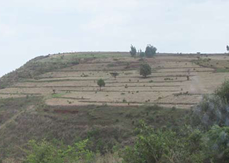Climate Smart Agriculture: Way to go
The Government of Kenya is fully aware that the progress being made towards food security, poverty reduction and sustainable development is at risk due to adverse impacts of climate change
Historical records show that Kenya has experienced rising temperatures over the last 50 years coupled with intense and extreme climate and weather events like droughts and floods
 zzIn response to this the Kenyan Government through the Ministry of Agriculture, Livestock and Fisheries launched the Kenyan Climate Smart Agriculture Framework (KCSAF) 2018-2027 to mitigate the risks of climate change through realization of climate resilient and low carbon growth sustainable agriculture which will ensure food security and contribute to national development goals in line to vision 2030.
zzIn response to this the Kenyan Government through the Ministry of Agriculture, Livestock and Fisheries launched the Kenyan Climate Smart Agriculture Framework (KCSAF) 2018-2027 to mitigate the risks of climate change through realization of climate resilient and low carbon growth sustainable agriculture which will ensure food security and contribute to national development goals in line to vision 2030.
The Framework is supposed to explore climate smart practices relating to sustainable intensification of crop, agroforestry, livestock and fisheries production; adaptation and mitigation practices in livestock production systems; efficient management of agricultural commodity value chains; opportunities to leverage climate finance for CSA; knowledge sharing and effective learning; strengthening key institutions and systems for CSA initiatives; and mainstreaming CSA elements into national policies and development planning process.
The following partners have spearheaded this campaign to ensure Kenyan transform its farmers to adopt climate smart agricultural practices in order to realize food security and sustainability; FAO, NEPAD, UNDP, DFID, CLIMATE CHANGE Agriculture and Food Security and COMESA. Climate smart campaign kickstarted in 2017 and though we still have a long way to go as a far achieving sustainable agriculture; the government is on the right track in training farmers on the best farming practices in a climate changing planet.
Food security will be realized with a paradigm shift of farmers to modern agricultural practices. This shift will enhance maximum production in spite of climate change and the dangers of drought. The achievement of this milestone will result in maximum yields which ascertain food security and sustainability. There is need for more investment in the climate smart agriculture campaigns across the country if the government is fully committed to their food security agenda.
What is Climate Smart Agriculture?
Climate Smart Agriculture (CSA) is an approach that aids in guiding actions needed to transform and reorient agricultural systems to effectively support development and ensure food security in a changing climate. CSA helps to develop agricultural strategies to secure sustainable food security under climate change. It provides means for stakeholders from local to national and international levels to identify strategies suitable to their local conditions. CSA forms an important part of FAO’s strategic objectives which is in line with FAO’s vision for sustainable food and agriculture and it also supports FAO’s goal to make agriculture, livestock and forestry more productive and sustainable. Climate Smart Agriculture aims to tackle three major objectives;
- To sustainably increase agricultural productivity and incomes
- Adapting and building resilience to climate change
- To reduce/remove greenhouse gas emissions
These three objectives are geared towards realization of sustainable agriculture across the agricultural value chain.
Sustainable Agriculture
How do we tell when our agricultural practices are sustainable? There are three components which are of great significance to sustainable agriculture; environmental health, economic profitability, and social and economic equity. Sustainable agriculture occurs when a society can meet its food and textile needs in the present without compromising the ability of the future generations to meet their own needs. Sustainability in agriculture contributes immensely towards climate smart agriculture as it ensures an increase in production and incomes, adaption to climate change and protection of environmental health.
To achieve sustainable agriculture, farmers may use different practices to promote soil health, minimize water use and lower pollution levels in the farms. Consumers and retailers in the sustainability chain can look for value-based foods that are grown using climate smart agriculture framework and also promotes farmworkers wellbeing.
The integration of climate smart agriculture in your farming processes will definitely generate some sustainability out of it. If your farming ventures are not profitable, if the quality of your life as a farmer is not improving and those of your family members and the society at large then you as a farmer has a lot to do in order to make your investment sustainable. The changing climate means that we ought to embrace innovations and transform our farms to adopt modern practices to maximise yields and enhance food security.
Climate Smart Agriculture; the Kenyan Way
According to the Kenya’s national development blue print, the Kenya Vision 2030, Kenya envisions being a middle-income country with citizens enjoying high quality of life and a sustained annual economic growth rate of at least 10% by year 2030. The agriculture sector is one of the key sectors to contribute to the projected annual national economic growth.
The Government of Kenya is fully aware that the progress being made towards food security, poverty reduction and sustainable development is at risk due to adverse impacts of climate change. Historical records show that Kenya has experienced rising temperatures over the last 50 years coupled with intense and extreme climate and weather events like droughts and floods. Future climatic predictions for Kenya indicate possible temperature increase of 1ºC by 2020 and 2.3ºC by 2050.
These changes unless effectively mitigated, will likely result to erosion of the productive assets and the weakening of coping strategies and resilience of rain-fed farming systems, especially in the arid and semi-arid lands. This will lead to more climate related vulnerabilities thereby predisposing farming communities to food insecurity and more poverty.